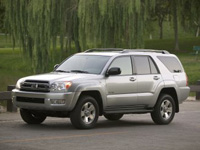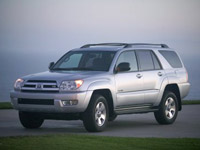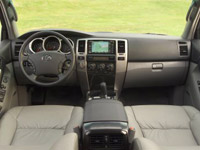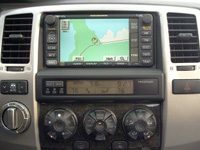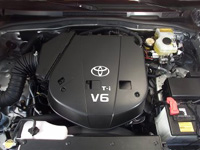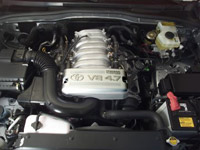|
Main Menu
|
|
|
|
4Runner History
|
|
|
|
Other
|
|
|
|
|
| 2005 4Runner History: |
The following changes are made for the 2005 model year.
1. Model Line-up
On the 1GR-FE engine model, the 4-speed automatic transmission has been discontinued, and a 5-speed
automatic transmission has been added.
2. Exterior
On the SR5 grade model, the radiator grille has been changed to a chrome-plated type.
On the models other than the SR5 sports edition, the color of the roof rail has been changed from silver to black.
The design of the rear spoiler, which is available as optional equipment on all models, has been changed.
The color of the side cover and the end cover of the lighted side steps has been changed from silver to black.
The following exterior color has been added: 3Q3 Dark Red Mica Metallic
3. Interior
On the model with the rear No. 2 seat, a speaker grille has been provided on the deck trim, along with the
addition of the 8-way speaker models.
4. 1GR-FE Engine
The tailpipe emission regulation has been changed from ULEV to LEVII-ULEV.
To comply with the LEVII-ULEV tailpipe emission regulations, the capacity of the catalysts that are provided in the
exhaust manifold and the front pipe has been changed. The VVT sensor has been changed from a pick-up type to a MRE
(Magnetic Resistance Element) type. The oxygen sensor has been changed from a planar type to a cup type. The evaporative
emission control system has been changed in order to comply with the LEV-II evaporative emission regulations.
5. 2UZ-FE Engine
A VVT-i (Variable Valve Timing-intelligent) system has been newly adopted to improve fuel economy and engine performance,
and reduce exhaust emissions. An ACIS (Acoustic Control Induction System) has been newly adopted to increase the power
output of the engine. Air injection system is newly adopted. This system uses an electric air pump for pumping air from
the electric air pump to exhaust port of the cylinder head. This ensures the proper warm-up performance of TWC when
starting a cold engine condition. The tailpipe emission regulation has been changed from ULEV to LEVII-ULEV. The
evaporative emission control system has been changed in order to comply with the LEV-II evaporative emission regulations.
To reduce exhaust gases, the number of TWCs (Three-way catalytic Converters) in the front exhaust pipe has been changed
from one to two. The Compression Ratio is now 10.0:1 while the 2004 model was 9.6:1. Horsepower goes to 270 from 245.
Torque goes to 330 from 315 ft. lbs.
6. Automatic Transmission
On the 2005 4Runner, the A340E and A340F 4-speed automatic transmissions have been changed to the
A750E and A750F 5-speed automatic transmissions [Super ECT (Electronically Controlled Transmission)]
for the 1GR-FE engine model.
7. Differential
With the adoption of the A750E and A750F 5-speed automatic transmissions for the 1GR-FE engine model,
the differential gear ratio is changed to 3.727 from 3.909.
8. Brake
A newly developed hydraulic brake booster with the built-in skid control ECU has been adopted for the
brake control system with VSC (Vehicle Stability Control) on the 2UZ-FE (4WD) and 1GR-FE engine models as standard
equipment. The Auto LSD (Limited Slip Differential) for the brake control system [ABS with EBD (Electronic Brake
force Distribution), Brake Assist, TRAC (Traction Control), VSC and DAC (Downhill Assist Control)] of 2WD has been
newly added as standard equipment. The CAN (Controller Area Network) communication system has been adopted
for the brake control system.
9. Multiplex Communication
All models have adopted the CAN (Controller Area Network) communication.
10. Air Conditioning
On all models, the ECU that controls the compressor has been changed.
11. SRS Airbag System
A front passenger occupant classification system has been adopted as standard equipment on all models.
12. Navigation with AV System
On the models with the 5-speed automatic transmission, the navigation system has been updated with the addition of
new functions. Along with the updated navigation system, an 8-speaker JBL speaker system has been adopted.
The navigation voice guidance is available in two languages: English and French.
The fourth-generation Toyota 4Runner sport utility vehicle (SUV), which was completely redesigned in 2003, gains more power for its available V8 engine for 2005.
With the V6 engine, a five-speed automatic transmission replaces the four-speed automatic, improving performance.
Equipping the 4Runner's available 4.7-liter i-Force V8 engine with the variable valve timing with intelligence (VVT-i) system and an electronic throttle control system
with intelligence (ETCS-i) has significantly increased output from 235 horsepower to 270.
Torque rises by 10 lb-ft., to 330 lb-ft.
The five-speed automatic transmissions in all 4Runner models provide seamless shift quality, and shift logic holds gears on inclines for power and on
descents for increased engine braking - helpful when towing. The transmissions are equipped with an Artificial Intelligence (AI) shift control,
which changes gear-shifting patterns according to driving conditions and driver input.
Like all Toyota SUVs for 2005, the 4Runner comes standard with the safety benefits of the Star Safety System,
which includes Vehicle Stability Control (VSC) and traction control (TRAC), an anti-lock brake system (ABS) with Electronic Brake-force Distribution (EBD) and Brake Assist.
Safety in the 4Runner has been enhanced for 2005 with the addition of driver and passenger advanced dual-stage front airbags that inflate according to collision severity.
A front passenger seat sensor verifies if there is a person in the seat as well as the person's weight category to determine whether the airbag should inflate, and the correct inflation power.
Available front and rear curtain and front seat mounted side-impact airbags are now equipped with a rollover sensor and cutoff switch.
Also new for 2005, the optional navigation system in 4Runner Limited gains new software and high-speed route processing for more convenience.
The aluminum 4.0-liter V6 engine, which is also equipped with the VVT-i and ETCS-i systems, produces 245 horsepower at 5,200 RPM and 282 lb.-ft. of torque at 3,400 RPM.
The V6 4Runner delivers EPA city/highway gas mileage estimates of 18/21 mpg for 2WD models and 17/21 for 4WD models.
EPA city/highway gas mileage estimates for the V8 are 16/20 for 2WD models and 15/19 for 4WD models.
All 4Runner models meet Low Emissions Vehicle (LEV) certification.
The 4Runner seats up to seven with an available third-row seat option.
The seat can fold over or be removed when additional cargo space is needed.
Advanced Drivetrains:
Four-wheel drive V6 4Runner models use a Multi-Mode shift-on-the-fly 4WD system with a Torsen® torque-sensing type limited-slip center differential with
locking feature. The driver can select 4WD or 2WD operation.
Driving with 4WD engaged provides more sure-footed handling on all types of road surfaces, whether dry,
wet or snow-covered, because power is applied to all four wheels.
The V8 4WD models feature a full-time four-wheel drive system with the Torsen limited-slip center differential with locking feature.
The Torsen differential distributes the power 40 percent front / 60 percent rear under most conditions and changes the ratio as needed based on
steering input and wheel slip. Changing to a 29 percent front / 71 percent rear distribution ratio during steering maneuvers helps to
enhance vehicle tracking through curves. If the rear wheels should spin, the center differential can change the ratio to
53 percent front / 47 percent rear to control the slippage.
The Torsen differential also makes the 4Runner less prone to slippage caused by sudden changes in road conditions,
such as driving through a puddle or ice patch.
All 4WD 4Runners are equipped with a two-speed transfer case with low range for handling steep
off-highway inclines or descents. Downhill Assist Control (DAC) is designed to augment the low-speed descending
ability of low-range by holding the vehicle to a target speed with no intervention from the driver.
The Hill-start Assist Control (HAC) system, standard on all models, helps provide additional control for off-road
driving by helping to keep the vehicle stationary while starting on a steep incline or slippery surface.
All 4Runner models are equipped with skid plates for the engine and fuel tank,
with 4WD models adding one for the transfer case, as well.
Rugged Chassis, Smooth Ride:
The 4Runner body-on-frame chassis features full-length boxed section frame rails that use large diameter body
mounts for high torsional rigidity and excellent cabin isolation from NVH. For towing convenience,
a standard tow hitch receiver bolts directly to the rear frame crossmember.
A draw bar, a high-capacity seven-pin electrical connector for trailer wiring and pre-wiring for an electric
trailer brake controller are also included as standard equipment.
Towing capacity is 5,000 pounds for V6 models, 7,000 pounds for V8 4WD models and 7,300 pounds for V8 2WD models.
Suspension is by double wishbone in the front with a four-link rigid type suspension in the rear, with coil
springs over gas shock absorbers. The 4Runner Limited V8 4WD model can be equipped with rear auto-leveling
air suspension for improved ride and performance when towing or hauling heavy loads.
This option is teamed with the unique X-REAS Sport Enhancement Suspension that is
standard on the 4Runner Sport Edition and optional on the Limited.
The X-REAS Sport Enhancement Suspension diagonally links the compression chambers of the shock absorbers
(front left shock linked to rear right and front right linked to rear left) via a central control absorber.
The system dramatically improves on-road handling and dampens body roll and pitch by passing small body motions
from front to rear to increase overall vertical shock damping.
Sophisticated Dynamic Control with Star Safety System:
The Star Safety System includes VSC, TRAC, ABS with EBD and Brake Assist to help provide optimal vehicle control
and driving safety. Four-channel, four-sensor ABS helps to prevent the wheels from locking during severe braking
conditions, while EBD distributes proper brake force between the front and rear wheels according to driving conditions.
Brake Assist is designed to determine if the driver is attempting emergency braking and, if the driver has not stepped firmly enough on the brake pedal to engage the (ABS), the system supplements the applied braking power.
The VSC system helps keep the 4Runner going on its intended course by detecting front-wheel slide and rear-wheel
slide during cornering and attempting to control either condition with torque intervention and/or by braking individual
wheels.
The system's traction control (TRAC) feature helps reduce tire slippage during acceleration.
The 4Runner 4WD models use an additional yaw sensor, a deceleration sensor, and control algorithms to
deliver smoother torque on any surface, including low-range and locked center differential conditions.
Automatic Limited-Slip Differential (LSD) is now standard on all 2WD models for improved traction in
slippery driving conditions.
Safety and Convenience Features:
In addition to the array of standard safety features, driver and front passenger seat-mounted side- and front-
and rear-side curtain airbags, and a roll over sensor with cutoff switch are available.
Cargo-area backup mirrors located on the D-pillars help provide enhanced visibility when reversing.
In 4Runner Limited, the optional navigation system also includes a rear-view camera that helps provide the driver a view of what's behind the vehicle. The camera automatically projects the image on the navigation system's seven-inch LCD screen when reverse gear is engaged.
A Tire Pressure Monitoring system (TPM) can detect a severe loss in pressure in one or more tires,
a condition that could potentially lead to loss of control.
An available moonroof with jam protection features a two-stage automatic pop-up wind deflector to help
minimize wind noise. The moonroof deflector lowers to an intermediate height when the vehicle is traveling
over 55 mph and rises to full height again when the vehicle speed drops below 45 mph and the roof is fully open.
All exterior glass shields 94 percent or more of UV rays, and the windshield, side windows and side mirrors use
water repellent glass. The rear gate is equipped with a standard power window with jam protection,
as well as an electric power close function to ensure it is not left partially ajar.
Three Model Grades:
The 4Runner is offered in three grade levels in two- and four-wheel-drive: the SR5,
the Sport Edition that features a distinct appearance and enhanced handling capabilities,
and the Limited grade with additional comfort amenities.
The SR5 grade is identified by a chrome grille and color-keyed bumpers and overfenders.
Standard features include fog lamps, black running boards, six-spoke 16-inch alloy wheels with P265/70R16 tires
(including a full-size spare tire with alloy wheel).
In addition to its X-REAS suspension, the 4Runner Sport Edition is distinguished externally
by a hood scoop, color-keyed grille and outside heated power mirrors, silver painted roof rails with black cross bars, silver painted bumper accents, black running boards and six-spoke 17-inch alloy wheels with P265/65R17 raised white letter tires.
The 4Runner Limited grade is identified by a color-keyed grille and outside heated power mirrors,
black illuminated running boards, black roof rails with cross bars and five-spoke 17-inch alloy wheels.
Spacious and Versatile Interior:
A sporty design and extensive standard comfort and convenience features complement the spacious cabin.
The two-tone dashboard houses a three-pod instrument cluster with orange illumination.
A vehicle level sensor detects when the 4Runner is on an incline and compensates the fuel gauge reading.
The instrument panel includes a scheduled maintenance indicator light.
Automatic climate control is standard on all models, with the Limited grade adding dual-zone temperature control in front.
A multi-information display, located just above the climate control panel, displays the climate control status as
well as a clock, outside temperature, fuel range meter, average speed, and average fuel consumption.
Manual eight-way driver (plus power adjustable lumbar support) and four-way passenger adjustable front seats
ensure comfort. The SR5 and Sport Edition grades feature cloth pattern upholstery, and the
Limited grade comes standard with leather-trimmed seats and power-adjustable front seats with heaters.
The 60/40-split fold-down rear seatbacks fold flat easily with no need to remove the headrests.
An extra-wide fold down rear seat center armrest includes an integrated pull-out convenience tray with two cupholders.
When equipped with the available third row seats, the middle row tumbles forward for easy third row access.
The large rear storage area includes steel tie-down hooks on the floor with additional storage hooks on the sidewalls.
A "double decker" cargo system with cargo net is standard on 4Runner Limited and optional for other models.
The cargo shelf can lie flat or be lifted up easily with one hand and locked in place to accommodate larger cargo
items (up to 66 pounds). Interior storage includes large bins in all doors.
Toyota Value in All Grades:
Standard equipment for the 4Runner SR5 model includes cruise control, power door locks and windows
(including rear gate window) with driver's auto up/down function, two 12v outlets, remote keyless entry with rear
hatch window power-down operation, a rear tonneau cover and illuminated entry.
The Sport Edition adds a tilt and telescoping steering wheel, high-contrast fabric-trimmed seats, a leather-wrapped
steering wheel with audio controls and cruise control buttons and a leather-wrapped shift knob.
The 4Runner Limited includes these features plus a standard anti-theft system with engine immobilizer,
rear seat audio with remote control and wireless headphone capability, HomeLink® tranceiver/garage door opener,
auto-dimming mirror with compass, leather-trimmed seats, a double-decker cargo system, and a cargo net.
Enhanced Navigation System for 2005:
An optional eight-speaker JBL AM/FM/CD audio system including navigation system with a touch-screen monitor
and voice guidance is available on 7-passenger 4Runner Limited models. The navigation system has been enhanced
for 2005 with new-generation software. The system features more than five million verified data points, and its route
searching capabilities are more than twice as fast as competitive systems.
Map data for the contiguous United States and major cities in Canada is stored on one digital versatile disc (DVD).
A Deluxe 3-in-1 AM/FM/Cassette/CD system with six speakers is standard in all models. An optional 360-watt JBL
Synthesis 3-in-1 sound system features 10 speakers, rear seat audio with remote wireless headphone capability,
a remote control, and a leather-wrapped steering wheel with integrated cruise control buttons and audio controls.
The leather-wrapped steering wheel is also available with the Deluxe 3-in-1 audio as stand-alone options, and the
JBL Synthesis is available with a six-disc CD changer.
With the additional appearance changes and powertrain upgrades,
the base MSRP for 4Runner 4x2 models ranges from $27,495 for the SR5 V6 to $35,220 for the
Limited V8. The new base pricing reflects an average MSRP increase of $259, or 0.9 percent.
For 4Runner 4x4 models, the base MSRP ranges from $29,770 for the SR5 V6 to $37,495 for the
Limited V8 reflecting an average MSRP increase of $288, or 0.9 percent.
Toyota's 36-month/36,000 mile basic new-vehicle warranty applies to all components other than normal wear and
maintenance items. Additional 60-month warranties cover the powertrain for 60,000 miles and corrosion with no mileage limitation.
Toyota Motor Sales, U.S.A., Inc., reported 2005 4Runner total calendar year-end sales of 103,830 units, down 9.1% from prior year.
2005 Standard Equipment, Optional Equipment and Specifications brochure (PDF)
2005 Full Standard Equipment Listing (PDF)
2005 Full Option Listing (PDF)
2005 Full Technical Specifications (PDF)
2005 Pocket Reference Guide (PDF)
|
|

